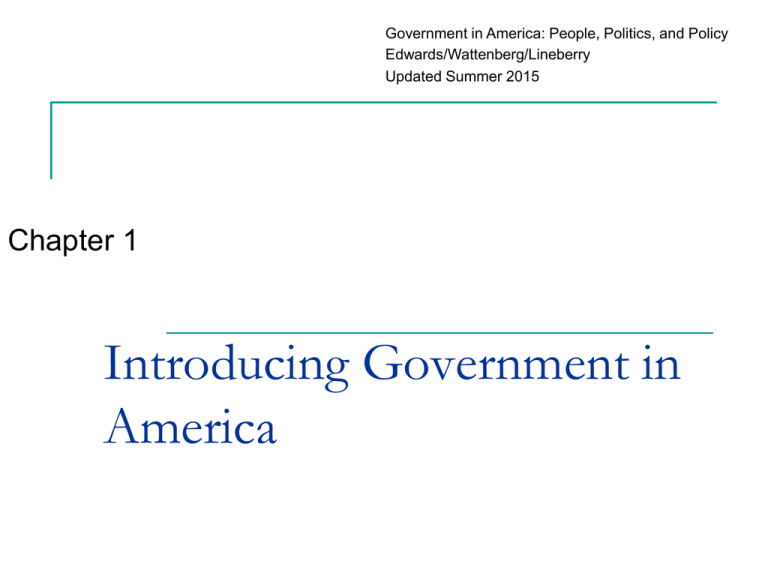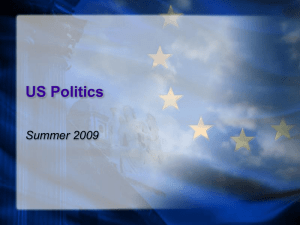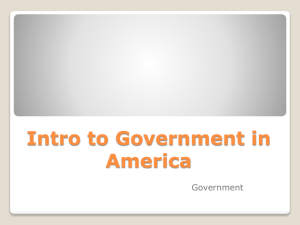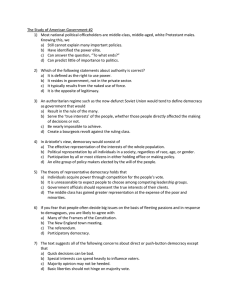Chapter 1 - TeacherWeb
advertisement

Government in America: People, Politics, and Policy Edwards/Wattenberg/Lineberry Updated Summer 2015 Chapter 1 Introducing Government in America Introduction Politics and government matter! How has the government impacted your life? Multiple levels: federal, state and local City vs. County: Did you know? A quote from President Obama (when he first ran for public office in 1993) “Politics does matter. It can make the difference in terms of a benefit check. It can make the difference in terms of school funding. Citizens can’t just remove themselves from that process. They actually have to engage themselves and not just leave it to the professionals.” Apathy Americans are apathetic about politics and government. American youth are not likely to be informed about government and politics and rarely participate in politics. Reasons? Believe politicians don’t listen, feel they can’t make a difference, think the system is corrupt 2008 Presidential election was the exception (“Year of the Youth Vote”) but it’s too early to declare the death of apathy for the young FIGURE 1.1 Political apathy among young and old Americans, 1972–2012 FIGURE 1.2 Age and political knowledge, 1972 and 2012 So what?? Remember, lack of interest means lack of information Why is political knowledge important? Fosters civic virtues like political tolerance People who understand policy issues incorporate this into voting behavior (policy voting) Promotes active political participation FIGURE 1.3 Election turnout rates of young and old Americans, 1972–2012 Young people don’t vote. So what? Participation = benefits It’s estimated that by 2020, Social Security, Medicare and other spending for the elderly will make up 51% of the domestic budget. Spending for children will be only 11% Older people vote, thus they receive attention and funds from the government What causes the apathy among youth? No policy has truly impacted them (draft, etc. for earlier generations) Watching the news is not their only option Fewer shared experiences Young people today have never known a time when most citizens paid attention to major political events. Changes in technology present both opportunities and challenges. What are they? Government Definition: Government is the institutions and people through which public policies are made for society. Congress, the President, the courts and the federal administrative agencies (“the bureaucracy”) Government This definition leads to two basic questions: How should we govern? Who holds power? Who influences policy? What should government do? Does the government do what we want it to? What should the “scope” of government be? What do governments do? Maintain national defense Provide public goods and services Two types: collective good–cannot be denied to anyone, provided by the government (clean air, etc.) Public goods provided by public or private sector – college loans, medical services, etc. Preserve order Socialize the young Collect taxes Politics Definition: Politics is the process by which we select our governmental leaders and what policies they produce—politics produces authoritative decisions about public issues. Laswell’s definition of politics Who gets what, when and how? Let’s break down this definition Who? What? When? How? Remember, in politics there are winners and losers! Political Participation Definition: All the activities used by citizens to influence the selection of political leaders or the policies they pursue. Most common? Other examples? Single-issue groups: Groups that have a narrow interest, on which their members tend to take an uncompromising stance The process by which policy comes into being and evolves over time. Figure 1.4 Figure 1.3 People are the start and end of the policymaking system Interests Problems Concerns Linkage Institutions Definition: Linkage institutions are the political channels through which people’s concerns become political issues on the policy agenda. They link the people to the government. They are NOT the government itself. Political Parties Elections News & Entertainment Media Interest Groups Policy Agenda Definition: The policy agenda are issues that attract the serious attention of public officials. Political issues arise when people disagree about a problem and how to fix it. Some issues will be considered, and others will not. A government’s policy agenda changes regularly. Policymaking Institutions Definition: Policymaking institutions are the branches of government charged with taking action on political issues. Branch Who’s In It? Duty Executive President Carry out the law Legislative Congress (House and the Senate) Make the law Judicial Federal Courts Interpret the law Bureaucracy (called the 4th branch) Federal departments, agencies, commisions, etc Carry out the laws for the Pres and Congress Policies Impact People Public Policy: a choice that government makes in response to a political issue Type Definition Example Congressional statute Law passed by Congress The $787 billion American Recovery and Restoration Act Presidential action Decision by the President Deploying or withdrawing troops from Iraq and Afghanistan Court decision Opinion by the Supreme Court or other court Supreme Court upholds citizens‘ rights to own guns Budgetary choices Congress enacts taxes and expenditures The federal budget is passed by Congress Regulation Regulation adopted by federal agency Dept of Ed issues guidelines for student loan forgiveness program Policies Impact People Impacts of Policies: Does it solve the problem? Does it create more problems? Depending on the answer, policy impacts carry the political system back to its point of origin: the concerns of people. Democracy Definition: Democracy is a system of selecting policymakers and of organizing government so that policy represents and responds to the public’s preferences. Components of Traditional Democratic Theory: Robert Dahl Equality in voting – one person, one vote Effective participation – we have to have adequate and equal opportunities to express our preferences Enlightened understanding – free press & speech Citizen control of the agenda – we have the collective right to control the government’s agenda. It should not be controlled by any ONE group. Inclusion – government must include, and extend rights to all those subject to its laws; citizenship must be open to everyone Characteristics of democratic societies Majority rule Minority rights representation Types of democracies (not explained in the book, so put it in your notes ) Direct democracy – exists only on a small scale (example: New England town meetings) Indirect democracy – otherwise known as representative democracy. We choose people to represent our needs and concerns and they create policy for society. Theories of U.S. Democracy Pluralist Theory A theory of government and politics emphasizing that politics is mainly a competition among groups, each one pressing for its own preferred policies Groups will work together Public interest will prevail through bargaining and compromise This competition is seen as a positive thing Theories of U.S. Democracy Elite and Class Theory A theory of government and politics contending that societies are divided along class lines and that an upper-class elite will rule, regardless of the formal niceties of governmental organization Not all groups equal Policies benefit those with money and power Belief that elites rule societies in many arenas: government, business, military, etc. Theories of U.S. Democracy Hyperpluralism A theory of government and politics contending that groups are so strong that government is weakened. Groups control policy and prevent government from acting Difficulty in coordinating policy implementation Confusing and contradictory policies result from politicians trying to placate every group – result is often “policy gridlock” Challenges to Democracy Increased Complexity of Issues– it has become difficult to know all we need to regarding government benefits, price supports, etc. Limited Participation in Government – we don’t take our role in our democracy seriously enough Escalating Campaign Costs – influence of PACs and money over democracy Diverse Political Interests – too many interests, no real majority, nothing really gets accomplished (policy gridlock) American Political Culture and Democracy Political Culture: An overall set of values widely shared within a society. American culture is diverse and comprised of: Liberty Egalitarianism – belief that we are all equal Individualism Laissez-faire – “hands off”, belief in free markets and limited govenment Populism – supporting the rights of average citizens in their struggle against privileged elites, “put the people first” A Culture War? There is concern among some scholars that there is sharp polarization into liberal vs conservative political cultures in America President Obama talked about there NOT being red and blue states, just the UNITED States. Is he right? David Horsey LA Times Red v Blue States Part 1 David Horsey Cartoon Part 2 How Active is American Government? It spends about $3.5 trillion annually It employs nearly 2.7 million civilians and 1.4 million members of the military It owns one-third of the land It occupies 3.2 billion square feet of office space It owns and operates 400,000 nonmilitary vehicles Summary Young people are apathetic about government and politics, even though they affect everyone. Democratic government, which is how the United States is governed, consists of those institutions that make policy for the benefit of the people. What government should do to benefit the people is a topic central to questions of American government.








